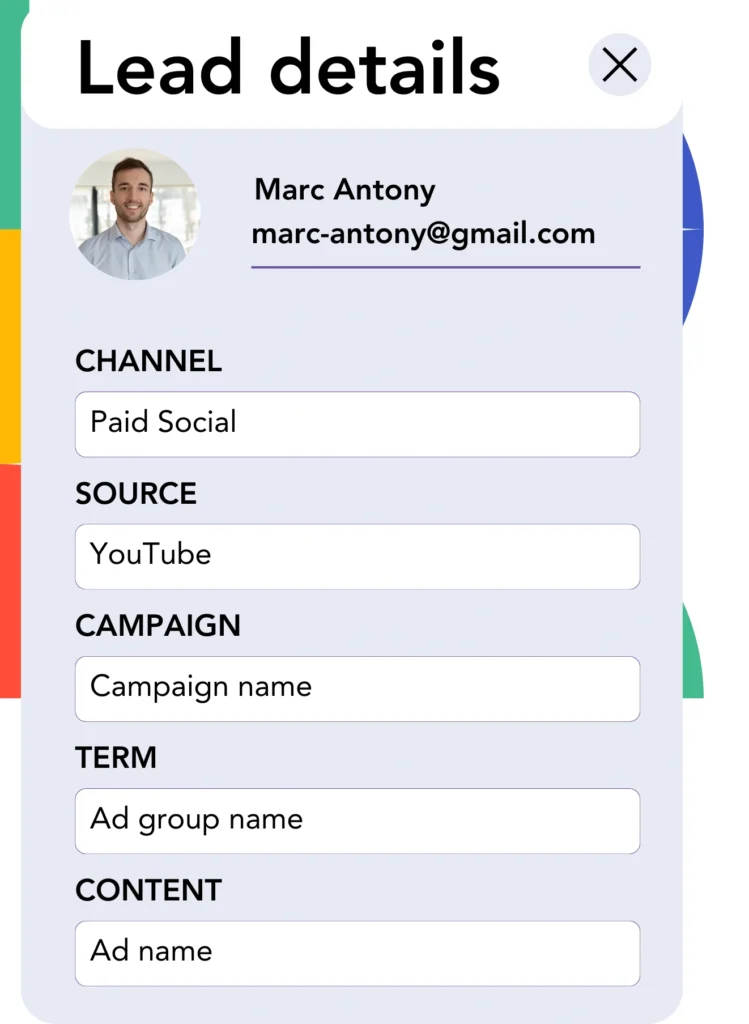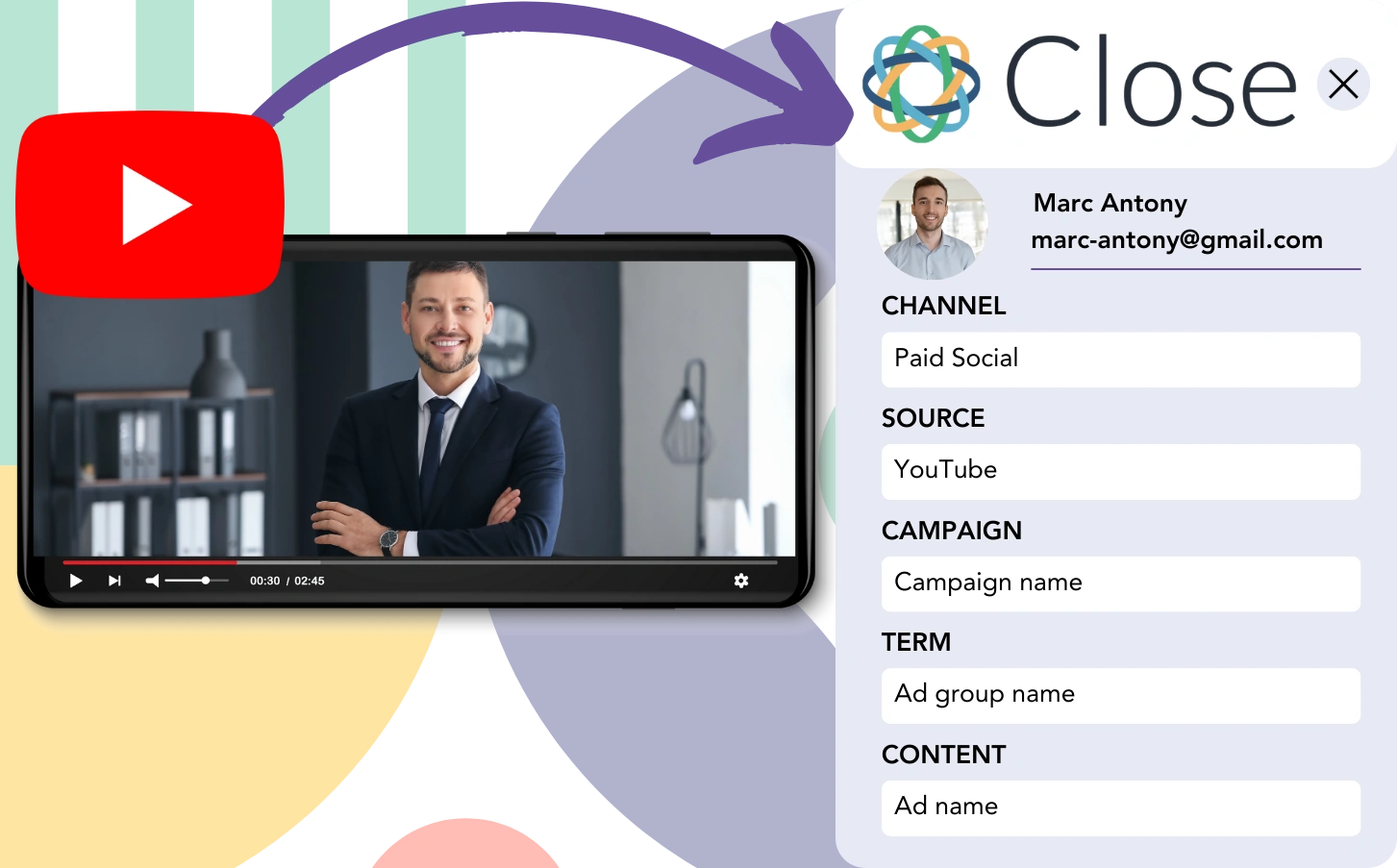Leads generated from YouTube are integrated into Close CRM, but they can’t be traced back to the specific YouTube ads. Furthermore, when a lead becomes a customer, identifying the exact YouTube ad remains unachievable.
Without proper tracking, evaluating your YouTube ads performance is impossible, making it challenging to know which ads attract leads and customers. This leads to spending on ads without clear insight into their success.
Thankfully, it’s possible to directly link each lead to the specific YouTube campaign, ad group, and ad that generated it.
Let’s break it down into steps!
How to Track YouTube Ads in Close CRM
Step 1: Add Leadsources in the head tag of your website

Leadsources helps identify where your leads come from. After it’s installed on your site, it captures up to 7 source data points for each lead.
➡️ Sign up to Leadsources.io for free
➡️ Add the Leadsources tracking code to your site
Step 2: Add the UTM parameters to your YouTube Ads

In your ad URL, place UTM parameters to capture campaign, ad group, and ad information from YouTube ads. Here’s a sample:
UTM_source=YouTubeUTM_campaign=campaign-nameUTM_term=ad-group-nameUTM_content=ad-name
The final URL should appear like this:
https://www.yourdomain.com/?&UTM_source=youtube&UTM_campaign=campaign-name&UTM_term=ad-group-name&UTM_content=ad-nameNote: Leadsources tracks lead source data without requiring UTM parameters, ensuring complete tracking.
Step 3: Add the hidden fields in your form

Hidden fields are form elements that are not visible but contain information that gets included when the form is submitted.
The lead source information is stored in hidden fields by Leadsources. When the lead submits the form, Leadsources fills them with YouTube Ads data.
Step 4: Capture the YouTube Ads data in Close CRM

Leadsources fetches YouTube campaign, ad group, and ad data along with additional details when users click on your ads and visit your site.
Leadsources fills the hidden fields on your form with the YouTube ad data it gathers.
When you submit the form, Close CRM will display both the YouTube ad data and lead details (connecting your form to Close CRM is a must).
How does Leadsources work?
Each time a visitor lands on your site, Leadsources fetches YouTube ad data and populates it into the hidden fields on your form. Once the form is submitted, this data and lead details like name and email are transferred to Close CRM.
Every lead tracked by Leadsources is linked with its source data:
| Lead source data | Fetched automatically |
| Channel | ✅ |
| Source | ✅ |
| Campaign | ✅ OR use UTM_campaign |
| Content | UTM_content parameter is required |
| Term | UTM_term parameter is required |
| Landing page | ✅ |
| Landing page subfolder | ✅ |
As outlined in the table above, when UTM parameters can’t be applied—like with organic sources such as Google search or when your website is published in an article—Leadsources will still track the following lead source data:
- Channel
- Source
- Campaign
- Landing page
- Landing page subfolder
Unlike most tools, Leadsources captures lead source information across both paid and organic marketing channels.
Performance reports: Lead, sales, and revenue by source
By capturing YouTube Ads data in Close CRM, you can generate performance reports that include:
- Leads, sales, and revenue by channel
- Leads, sales, and revenue by source
- Leads, sales, and revenue by campaign (aka. YouTube campaign)
- Leads, sales, and revenue by term (aka. YouTube ad group)
- Leads, sales, and revenue by content (aka. YouTube ad)
By using this information, you can adjust your YouTube Ads budget to focus on the campaigns, ad groups, and ads that are most effective at driving leads, sales, and revenue.
Let’s check out a few reports you can generate!
1. Lead source reports
Create performance reports that indicate the number of leads created by:
- Channel
- Source
- Campaign (aka. YouTube campaign)
- Term (aka. YouTube ad group)
- Content (aka. YouTube ad)
- Landing page
- Landing page subfolder
Example #1: Leads by channel
This report helps you understand which channel is performing the best in lead generation.

Example #2: Leads by YouTube campaign
This allows you to track lead generation by focusing on a specific source (e.g., YouTube) and observing each campaign’s performance.

Example #3: Leads by YouTube ad
After determining the YouTube campaign that generates the most leads, you can break down the specific ad group or ad that’s driving the leads.

2. Sales and revenue source reports
With the knowledge of which YouTube campaign, ad group, and ad generate leads, it’s time to assess whether those leads are converting into sales and revenue.
Connect your leads to a CRM like Close CRM, enabling you to track sales and revenue generated by all channels, sources, YouTube campaigns, ad groups, ads, landing pages, and subfolders.
By analyzing these insights, you can adjust your YouTube Ads strategy to target the channels, sources, campaigns, ad groups, and ads that bring in the highest sales and revenue.
It’s possible to create a range of reports for sales and revenue, including:
- Sales and revenue by channel
- Sales and revenue by source
- Sales and revenue by campaign
- Sales and revenue by term (e.g., YouTube ad group)
- Sales and revenue by content (e.g., YouTube ad)
- Sales and revenue by landing page
- Sales and revenue by landing page subfolder
Example Scenario:
| Channel | Search Paid | Social Paid |
|---|---|---|
| Leads | 50 | 75 |
| Sales | 5 | 6 |
| Average Order Value | $150 | $100 |
| Revenue | $750 | $600 |
After launching ads on YouTube and Google, the first “Leads by Channel” report indicated that YouTube’s Social Paid ads performed better than Google’s Search Paid ads in terms of lead generation.
Upon examining the sales and revenue data in Close CRM, you realized that the Search Paid channel delivered more revenue with fewer leads compared to the Social Paid channel. This insight led you to adjust your budget to focus more on the Search Paid channel.
LeadSources tracks the source of each lead in Close CRM, whether they come from ads, organic search, social, email, etc. and syncs that data with each submission. See the full breakdown on the lead source in Close CRM page.

